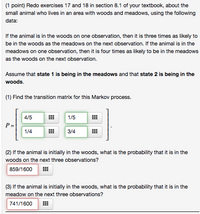
Advanced Engineering Mathematics
10th Edition
ISBN: 9780470458365
Author: Erwin Kreyszig
Publisher: Wiley, John & Sons, Incorporated
expand_more
expand_more
format_list_bulleted
Topic Video
Question
Please Help with the image attached!

Transcribed Image Text:(1 point) Redo exercises 17 and 18 in section 8.1 of your textbook, about the
small animal who lives in an area with woods and meadows, using the following
data:
If the animal is in the woods on one observation, then it is three times as likely to
be in the woods as the meadows on the next observation. If the animal is in the
meadows on one observation, then it is four times as likely to be in the meadows
as the woods on the next observation.
Assume that state 1 is being in the meadows and that state 2 is being in the
woods.
(1) Find the transition matrix for this Markov process.
1/5
4/5
P =
1/4
3/4
(2) If the animal is initially in the woods, what is the probability that it is in the
woods on the next three observations?
859/1600
(3) If the animal is initially in the woods, what is the probability that it is in the
meadow on the next three observations?
741/1600
Expert Solution
This question has been solved!
Explore an expertly crafted, step-by-step solution for a thorough understanding of key concepts.
This is a popular solution
Trending nowThis is a popular solution!
Step by stepSolved in 2 steps

Knowledge Booster
Learn more about
Need a deep-dive on the concept behind this application? Look no further. Learn more about this topic, advanced-math and related others by exploring similar questions and additional content below.Similar questions
- what about the horizontal translation?arrow_forwardPlease include all stepsarrow_forwardIt's true sand dunes in Colorado rival sand dunes of the Great Sahara Desert! The highest dunes at Great Sand Dunes National Monument can exceed the highest dunes in the Great - Sahara, extending over 700 feet in height. However, like all sand dunes, they tend to move around in the wind. This can cause a bit of trouble for temporary structures located near the "escaping" dunes. Roads, parking lots, campgrounds, small buildings, trees, and other vegetation are destroyed when a sand dune moves in and takes over. Such dunes are called "escape dunes" in the sense that they move out of the main body of sand dunes and, by the force of nature (prevailing winds), take over whatever space they choose to occupy. In most cases, dune movement does not occur quickly. An escape dune can take years to relocate itself. Just how fast does an escape dune move? Let x be a random variable representing movement (in feet per year) of such sand dunes (measured from the crest of the dune). Let us assume that…arrow_forward
arrow_back_ios
arrow_forward_ios
Recommended textbooks for you
 Advanced Engineering MathematicsAdvanced MathISBN:9780470458365Author:Erwin KreyszigPublisher:Wiley, John & Sons, Incorporated
Advanced Engineering MathematicsAdvanced MathISBN:9780470458365Author:Erwin KreyszigPublisher:Wiley, John & Sons, Incorporated Numerical Methods for EngineersAdvanced MathISBN:9780073397924Author:Steven C. Chapra Dr., Raymond P. CanalePublisher:McGraw-Hill Education
Numerical Methods for EngineersAdvanced MathISBN:9780073397924Author:Steven C. Chapra Dr., Raymond P. CanalePublisher:McGraw-Hill Education Introductory Mathematics for Engineering Applicat...Advanced MathISBN:9781118141809Author:Nathan KlingbeilPublisher:WILEY
Introductory Mathematics for Engineering Applicat...Advanced MathISBN:9781118141809Author:Nathan KlingbeilPublisher:WILEY Mathematics For Machine TechnologyAdvanced MathISBN:9781337798310Author:Peterson, John.Publisher:Cengage Learning,
Mathematics For Machine TechnologyAdvanced MathISBN:9781337798310Author:Peterson, John.Publisher:Cengage Learning,


Advanced Engineering Mathematics
Advanced Math
ISBN:9780470458365
Author:Erwin Kreyszig
Publisher:Wiley, John & Sons, Incorporated

Numerical Methods for Engineers
Advanced Math
ISBN:9780073397924
Author:Steven C. Chapra Dr., Raymond P. Canale
Publisher:McGraw-Hill Education

Introductory Mathematics for Engineering Applicat...
Advanced Math
ISBN:9781118141809
Author:Nathan Klingbeil
Publisher:WILEY

Mathematics For Machine Technology
Advanced Math
ISBN:9781337798310
Author:Peterson, John.
Publisher:Cengage Learning,

